All 4 entries tagged Moulds
No other Warwick Blogs use the tag Moulds on entries | View entries tagged Moulds at Technorati | There are no images tagged Moulds on this blog
May 01, 2020
Casting Roman tokens: Notes on two unpublished token moulds from Florence collections
Whilst the interest in token moulds has mostly been confined to excavation reports and occasional enquiries to date, recent scholarship is increasingly focusing on the value of these objects to better understand crucial aspects related to the manufacturing techniques, production location and use of tokens in antiquity (cf. Pardini et al. 2016; Rowan 2019). Lately, token moulds are also gaining attention on the market and in auction sales.
Two unpublished token moulds are presented below, which exist as part of two museum collections from Florence, Italy. Both token moulds are discussed in a study currently being undertaken by the author.
The token mould shown on Fig. 1 is held in the Museo Archeologico of Firenze (MAF) (inv. no. 79209). It is one half of a mould made of limestone, rectangular in shape, whose size is 115 x 80 x 27 mm. It would have been used in conjunction with the other half (now lost) in order to create 8 circular tokens of about 16-17mm in diameter.
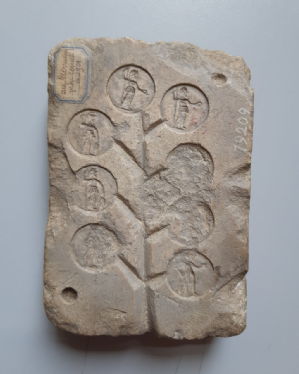 |
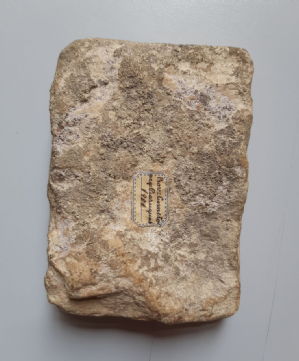 |
Figure 1: Roman token mould from Museo Archeologico Nazionale of Firenze (MAF) (inv. no. 79209) (Courtesy of the MAF).
Based on the designs engraved on the surface – but some of them are unfortunately in poor condition – the resulting tokens carried at least three different types of images: on the left side, two of the preserved designs show Mars, helmeted, in military dress, standing right, holding spear in right hand and resting left on shield on ground (the type is also applied to Minerva, who is generally portrayed with a longer robe); on the top, two token cavities depict Mars helmeted, in military dress, standing right, holding spear in right hand and patera in left hand; in the lower right corner, a token design shows Hercules standing right, holding scyphum in left hand and club in right hand. These images are variants of types commonly depicted on Roman lead tokens, as already known through the examples published by M. Rostowzew as well as on individual catalogues of museum collections (for some of the types in question, see e.g. Rostowzew and Prou 1900, 135, fig. 32; Arzone and Marinello 2019, nos. 108-111 and 113). It is noteworthy that the first of the two images of Mars mentioned above appears on the tokens produced at the time of Nero, and was adopted on official coinage just afterwards, occurring on the coins issued during the Civil Wars of AD 68-69 (Fig. 2). However, the designs attested on the MAF mould are closer to the variant of a Mars type largely found on coinage from the time of Trajan (Fig. 3) up to the fourth century, which allows us at least to date the token mould to this broad time frame. To support this, morphological and stylistic features, as well as the material used, are consistent with the token molds from Rome and Ostia, generally assigned to the period between the 1st and 3rd centuries AD.

Figure 2: Silver denarius, RIC 12 Civil Wars 20, AD 68-69. (UBS Gold & Numismatics, Auction 83, lot 183).
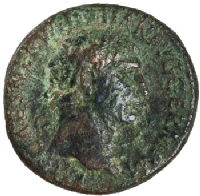 |
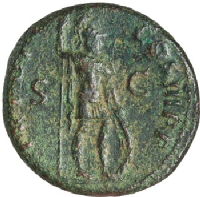 |
Figure 3: Bronze As of Trajan, Rome AD 99-100 (= RIC II, Trajan 410), American Numismatic Society (inv. no. 0000.999.18549)
This token mould is said to have been found in Corneto Tarquinia (Lazio), whose ancient site was one of the most important settlements of the twelve Etruscan cities (the ‘Dodecapolis’), and which was under Roman domination since the third century BC. This place does not appear among the sites documented as find spots of token moulds to date, which have been found in Rome and Ostia, except for two examples from Como and Telesia (Rowan 2019, 98-99). If one accepts as reliable the information on its place of discovery, this mould specimen might suggest that a local production of lead tokens existed in Tarquinia in the imperial period. Moreover, it has recently been assumed that a ‘distributed production’ rather than a centralized single workshop was the common ‘model’ for the manufacture of tokens over the Roman period, which would have been created ‘in multiple places by multiple individuals’ (cf. Rowan 2019, 97).
This piece was sold to the MAF on 10 May 1901 by the collector and member of the Accademia Colombaria Anton Domenico Pierrugues, who donated his collection of Greek and Roman coins to the museum after his death (1915).
 |
 |
Figure 4:Roman token mould from Casa Buonarroti, Florence (Lenzini Moriondo’s inventory (1964), 22/1) (Courtesy of Casa Buonarroti).
Fig. 4 illustrates one half of a token mould housed at Casa Buonarroti, whose collection was formed from the 16th to the 19th century from the bequest of Michelangelo Buonarroti and his descendants. The piece is made of limestone, quadrangular in shape, and is 83 x 76 (min. 73) x 28 mm in size. The other half of the artefact is lost also in this case. The mould would have created seven circular tokens of 14-15 mm in diameter, which were decorated with the image of the Three Graces on one side. This depiction is a popular type on Roman lead tokens. A bronze uniface Roman token (14mm, 2.90g) showing the Three Graces on one side while blank on the other side exists as part of the Casa Buonarroti collection. The iconography and size of this token perfectly match the token cavities of the mould, making it likely that the bronze tessera was cast through the mould in question (Figs. 5-6). Anyway, it is likely that this bronze token was a product of a sample casting from the mould after its discovery. This might be suggested by the absence of remains of casting sprues on the token specimen as well as by its uniface appearance, since it is highly probable that the other half of the mould containing casting branches to the cavities was also decorated (see below). However, no data is available about the place of discovery of the mould, and it is not possible to determine when precisely in modern times the tessera was cast.
 |
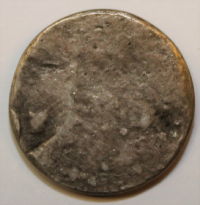 |
|
Figs. 5-6: AE Roman token (14mm, 2.90g), Casa Buonarroti, Florence.
The mould has a remarkable resemblance to a token mould of palombino marble with the same designs (105 x 75 mm for 7 circular tokens of ca. 17 mm) published by Cesano (1904, 11, fig. 1), which was found in the 19th century in Rome during the Lungotevere works. Such close ties might hint that the Casa Buonarroti mould came from Rome. According to ongoing research by the author, the mould may have been part of the inheritance of the antiquarian and senator Filippo Buonarroti (1661-1733), the great-grandnephew of Michelangelo Buonarroti, who stayed in Rome over the years ca. 1684-1699 serving as secretary, conservator of collections and librarian of the influential family of Cardinal Gasparo di Carpegna. In Rome, Filippo Buonarroti led a number of archaeological explorations which allowed him not only to assemble an impressive collection of Roman and Etruscan antiquities, but also to conduct pioneering studies in ancient iconography, epigraphy, and numismatics.
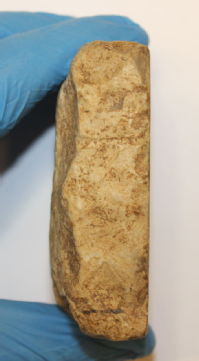 |
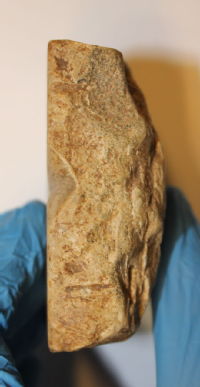 |
Figs. 7-8: Top and bottom sides of the mould from Casa Buonarroti, Florence.
Both token moulds show morphological and technical features which are largely documented for this class of objects. The extant half of the MAF mould shows a ‘herringbone’ arrangement, with a central casting channel with branches leading to the individual token moulds. The piece from Casa Buonarroti has instead only a central casting channel and no ‘branches’; one should assume that the now lost other half of the mould contained the channels through which molten lead was poured into the token cavities. In the top right and lower left corners, both molds bear the holes of the nails which were used to fasten both halves of the mould together, but also to ensure that they were correctly aligned (cf. Rowan 2019, 95). Furthermore, all four sides of the token mould from Casa Buonarroti carry small grooves which, as has been argued, would be suggestive of the use of wire which wrapped around the molds during the casting process (cf. Pardini et al. 2016) (Figs. 7-8). Also, as with a token mould from the Harvard Art Museums discussed by Rowan, a deep central hole is found in the center of each token cavity of the Casa Buonarroti mould, being visible in the guise of a protuberance on the body of one of the Graces in the resulting token, as is attested on the extant bronze tessera from Casa Buonarroti. This depression would be a clue of the method employed for engraving the token designs, since it would have been caused by the bit of a tool used for cutting the circular depressions before the designs were engraved. Finally, the back of both mold specimens is unworked, as attested on many moulds of this type.
Further analysis and the potential discovery of new specimens could help develop future discussion on the ancient token moulds, thus providing a more complete picture about the production and use of tokens in the ancient world.
 |
This blog was written by Cristian Mondello as part of The creation of tokens in late antiquity. Religious ‘tolerance’ and ‘intolerance’ in the fourth and fifth centuries AD project, which has received funding from the European Union’s Horizon 2020 research and innovation programme under the Marie Skłodowska-Curie grant agreement No 840737.
Select bibliography
A. Arzone and A. Marinello, Museo di Castelvecchio. Lead Tokens. Tessere di piombo (Modena, 2019).
L. Cesano, ‘Matrici e tessere di piombo nel Museo Nazionale Romano’, NSc. (1904), 11-17.
G. Pardini, M. Piacentini, A.C. Felici, M.L. Santarelli, and S. Santucci, ‘Matrici per tessere plumbee dalle pendici nord-orientali del Palatino. Nota Preliminare’, in A.F. Ferrandes and G. Pardini (eds), Le regole del gioco. Tracce, archeologi, racconti. Studi in onore di Clementina Panella (Rome, 2016), 649-667.
U. Procacci, La Casa Buonarroti a Firenze (Firenze, 1965).
M. Rostowzew, Tesserarum urbis Romae et suburbi (St. Peterburg, 1903).
M. Rostowzew and M. Prou, Catalogue des plombs de l’antiquité (Paris, 1900).
C. Rowan, ‘A Roman token mould in Harvard’, Coins at Warwick Blog.
C. Rowan, ‘Lead token moulds from Rome and Ostia’, in N. Crisà, M. Gkikaki, and C. Rowan (eds), Tokens. Culture, Connections, Communities (London, 2019), 95-110.
October 01, 2019
Hortensia Sperata, Token Issuer in Rome or Ostia
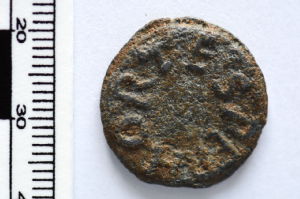 |
 |
Lead token from Rome or Ostia, now in the The Bibliothèque nationale de France in Paris (Rostowzew and Prou 422a). 12h, 20mm, 4.13g, TURS 1241.
Side A: HORTE SPER around in a circle.
Side B: Palm branch within a wreath.
Pictured above is a lead token, which, from the style of its design and its fabric, we can assign either to the city of Rome or to Ostia. What is remarkable about this piece is that the token carries the name of a Roman woman: Horte(nsia) Sper(ata). Her name circles around the edge of one side of the token in a way very similar to Roman coinage. The other side carries imagery commonly found on lead tokens in this region: a wreath and palm branch. These communicate to the user a festive, happy atmosphere.
This was not the only token that Hortensia issued. Another token carries her name in full: HORTENSIA SPERATA, with the same design (palm branch within wreath) on the other (TURS 1240). Two further tokens are smaller in diameter (13-15mm) and seem to carry an abbreviation of her name: HOR on one side and SPE or SP on the other (TURS 1242, 1243). Why would Hortensia have so many variant tokens? She might have wished to have two sizes of token (20mm and 13-15mm), with one perhaps worth more than the other, or with each representing different products or levels of access. An engraver could have created a mould for her tokens that cast both sizes at once, a practice known from other surviving examples.
 |
The palombino marble mould pictured here would have been utilised to make tokens during the Roman imperial period. It was found along with several others on the Esquiline Hill in Rome in 1882. Here we can find another individual responsible for tokens, whose name has been abbreviated to LVE (a practice also commonly found in graffiti). Like the tokens of Hortensia, we can see that LVE wanted two sizes of token: a larger and a smaller piece. On the smaller piece his initials have become ligate: i.e. they have been joined together ti fit into the reduced size. In a similar way Hortensia's name was abbreviated on her smaller tokens.
We do not know anything more about Hortensia Sperata, but one presumes she had a certain amount of wealth. From the men and women named on Roman lead tokens, some were magistrates in government or colleges; others appear to be linked to bath houses. Whatever the specific use of these tokens (and it is very hard to be certain), they were likely used in an act of patronage: the provision of necessary small change, for example, the sponsoring of a banquet or other event, or a distribution. The lead tokens of Rome and Ostia reveal a world otherwise unrecorded in our sources, where both men and women utilised these objects to cement personal relationships and consolidate local communities.
This coin of the month blog was written by Clare Rowan as part of the ERC-funded Token Communities in the Ancient Mediterranean Project.
June 01, 2018
A Roman Token Mould in Harvard
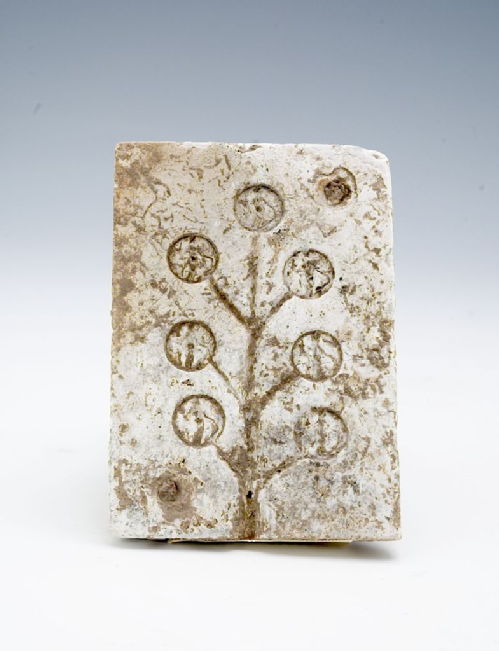 |
| Roman Token Mould from Harvard Art Museums, 2008.118 |
Amongst the McDaniel bequest to Harvard Art Museums in Boston is one half of a mould made of palombino marble. Shown here, this piece is one of the numerous moulds of this type used to cast Roman lead tokens. This particular mould half is 10.8x7.6x2.9cm and weighs 389.2g. It would have been used in conjunction with another half to cast seven circular lead tokens of c. 14mm, all carrying an image of the goddess Fortuna holding a cornucopia and rudder (and presumably another image on the other side, engraved on the other half of the mould). It has previously been published in Hirschland and Hammond 1968.
This type of token mould is characteristic of Rome and Ostia, and was donated to Harvard along with McDaniel's collection of Roman lead tokens and other antiquities. We know from McDaniel himself that he purchased his lead tokens (and thus probably also this mould) from the city of Rome. In his memoir, Riding a Hobby in the Classical Lands (p. 71), McDaniel writes:
“For the integrity of one dealer in Rome I can vouch unreservedly and so, as a contrast to some of the rest of my group, I name him here at the end of the chapter, honoris causa, Signore Scalco. His sunny face and smile alone used to lighten the tiny, gloomy shop not far from St. Peter’s in which he exposed for sale his modest stock of classical antiquities. A charming, well-informed Italian was he, who often had unusual things for sale. Thus, it was from him I bought a considerable number of papal medals…. From him, too, came my piombi, those coin-shapes of lead which have so much about them to pique the curiosity and to puzzle the best of scholars as they work on the problem of their various uses. While I almost never saw any customers in the shops of the other small dealers in Rome, Scalco was one who received calls from archaeologists, who liked to chat with him, and also from the proprietors of the more pretentious establishments, who would buy from him in order to sell again. There, too, one might chance at any time upon one of the rough dwellers of the Trastevere who had fished something out of the Tiber which he expected to have identified as modern, or, if good luck were his, to sell as an antiquity. He was just as sure as the most promising customer to receive all the attentions of courtesy and fair treatment; that was Scalco."
 |
|
Cast lead tokens
from Ostia.
|
The mould carries the channels through which molten lead was poured into the token cavaties; the resulting tokens were then broken off to be used (see the picture left for an example of what the resulting cast would have looked like before the tokens were broken off). The mould still contains the iron nails used to fasten both halves of the mould together (in the top right and lower left corners) - this would ensure that both halves of the mould were correctly aligned. The top and bottom sides of the mould carry faint grooves (see image below); it has been suggested that these grooves were created for or by wire that was wrapped around the moulds during the casting process (Pardini et al 2016). The back of the mould is unworked, as many moulds of this type are.
The top right corner of the Harvard mould has an unusual feature: two concentric circles are etched into the material (see image below). The inner circle is 14mm, the precise diameter of the tokens produced by this mould. These two circles may have been an error made by the person producing the mould, or they may in fact provide a clue as to how these moulds were made: perhaps two concentric circles were sketched before a design was carved into the inner circle- here, perhaps, it was decided that this additional token design was not needed. When one looks closely at each of the circular designs, one sees a deep circular depression at the centre, on Fortuna's body. Jack Kroll, in his unpublished catalogue of these pieces, suggested that this depression was caused by the bit of an instrument used for cutting the circular depressions before the designs were engraved (much like the point of a compass). Many Roman lead tokens carry circular protuberances at their centre; the Harvard mould allows us to understand these protuberances were the result of the mould manufacturing process rather than an intentional part of the design.
Images below from left to right: the side of the mould with faint grooves; a close up of the top left corner of the mould showing two concentric circles and a central depression on the body of Fortuna; a Roman lead token from the Harvard Art Museums collection (2008.116.41) with a wreath and a central dot, now understood to be a result of the mould making process.
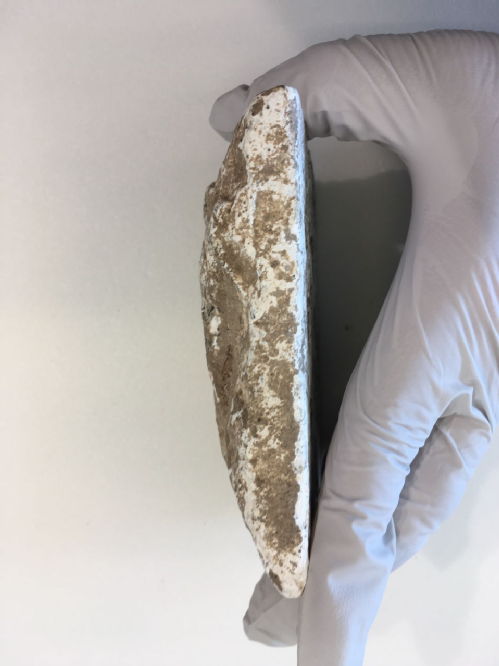 |
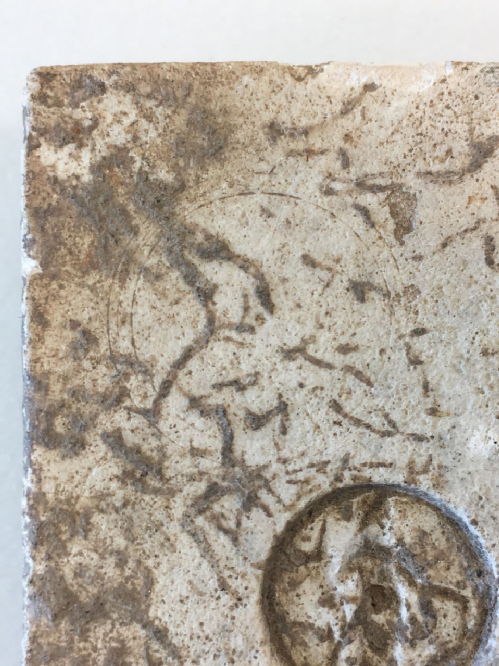 |
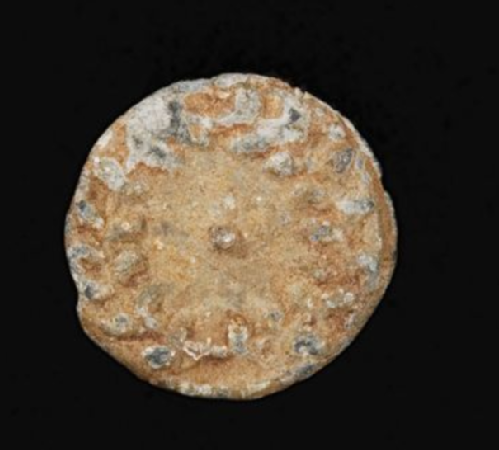 |
This coin of the month was written by Clare Rowan as part of the Token Communities in the Ancient Mediterranean Project.
Select Bibliography:
Hirschland, N. L. and M. Hammond (1968). Stamped Potters' marks and other stamped pottery in the McDaniel Collection. Harvard Studies in Classical Philology 72: 369-382.
Kroll, J. H. (unpublished manuscript). Roman Lead Tokens in Harvard Art Museums.
McDaniel, W. B. (1971). Riding a Hobby in the Classical lands. Cambridge, Mass., Harvard University Printing Office.
Pardini, G., M. Piacentini, A. C. Felici, M. L. Santarelli and S. Santucci (2016). Matrici per tessere plumbee dalle pendici nord-orientali del Palatino. Nota preliminare. In: Le regole del gioco tracce archeologi racconti. Studi in onore di Clementina Panella. ed. A. F. Ferrandes and G. Pardini, Edizioni Quasar: 649-667.
November 14, 2014
Coining in Roman Britain Part 3: Counterfeiting
During the late second and early third centuries AD more evidence has been discovered for the production of Roman coins in Britain. Found almost exclusively on archaeological sites, clay moulds for casting copies of Roman silver denarii have been excavated in their thousands across the country. These double sided disc shaped moulds, made by pressing a coin into clay, would have been arranged in rows, with molten metal poured from above. The moulds would then have been broken apart to gain access to the freshly copied coins. Moulds such as these have been discovered in large quantities in Somerset, London and the Midlands, with sporadic discoveries in Scotland. One might assume these moulds were used for making counterfeit coins, that is, coins intended to deceive the user. However, sites from continental Europe indicate these practises might not have been covert (moulds such as those found in Britain have been discovered surprisingly near to places of Roman establishment), suggesting a much more organised and possibly legitimate use of these tools. In contrast, the flat and open landscape of the Somerset Levels would be a seemingly ideal place for forgers to produce fake coins, and hide the evidence quickly should any figures of Roman authority appear. An in depth study into the context of Romano-British coin moulds may reveal the answer to the enigma.

Coin mould (lead) for casting imitation coins of Tetricus (AD 271-274). This mould was discovered in Nottinghamshire. Note the hole at the top of the mould, through which molten metal would have been poured. Image: Portable Antiquities Scheme, Unique ID: LVPL-0A5332.
 This month's coin series on Roman Britain is written by Dom Chorney, a young numismatist from Glastonbury, Somerset. He studied for his undergraduate degree at Cardiff (in archaeology), and achieved a 2:1. Dom is currently studying for an MA in Ancient Visual and Material Culture at the University of Warwick, and intends to undertake a doctorate in 2015. His main areas of interest are coin use in later Roman Britain, counterfeiting in antiquity, coins as site-finds, and the coinage of the Gallic Empire.
This month's coin series on Roman Britain is written by Dom Chorney, a young numismatist from Glastonbury, Somerset. He studied for his undergraduate degree at Cardiff (in archaeology), and achieved a 2:1. Dom is currently studying for an MA in Ancient Visual and Material Culture at the University of Warwick, and intends to undertake a doctorate in 2015. His main areas of interest are coin use in later Roman Britain, counterfeiting in antiquity, coins as site-finds, and the coinage of the Gallic Empire.
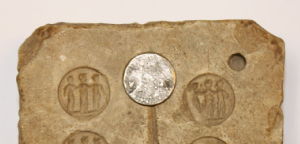
 Clare Rowan
Clare Rowan

 Please wait - comments are loading
Please wait - comments are loading

 Loading…
Loading…

